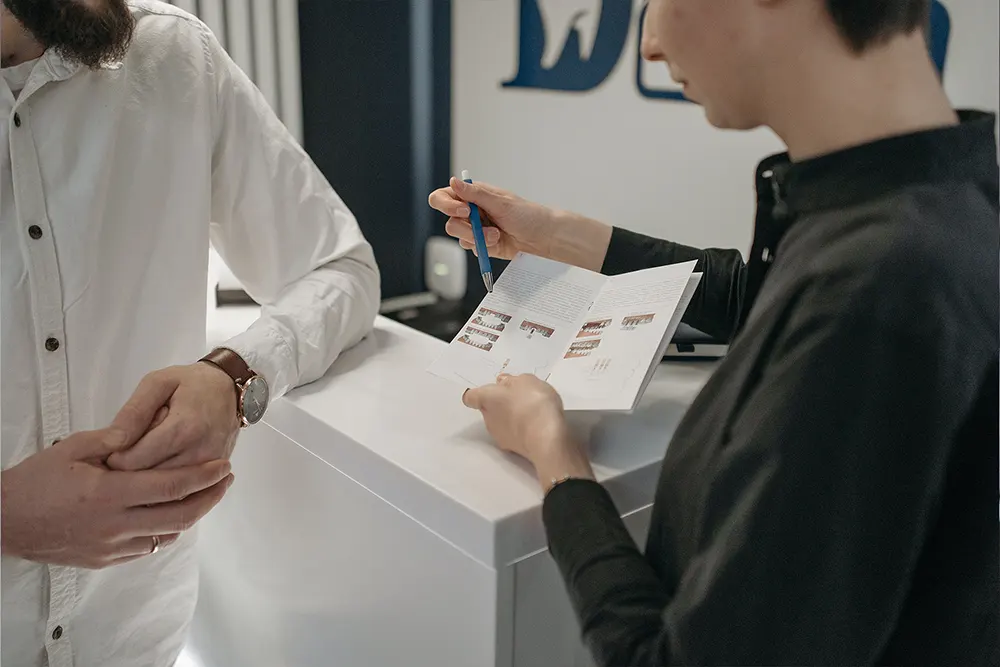How to leverage the power of an offline marketing strategy to boost your brand, drive customer engagement, and increase sales

What are marketing materials?
Whatever the size of your business, and however good your products or services, you won’t make sales unless you get your message out to the right people. You need to reach highly targeted prospects likely to convert. You also need to make sure that those new customers remember your brand, your products, and your services so that they come back for more and recommend your business to their friends and associates.
And this is where marketing comes in. There’re basically two kinds of marketing these days:
Digital and print marketing products
Marketing materials are all the means that you use to promote your brand, sell goods and services, or educate and inform your target customers. All successful businesses deploy a mix of methods. It’s a very unusual enterprise which is entirely digital or wholly offline.
Offline marketing materials are usually printed and can include any means by which you communicate your marketing message, your brand identity, and details of your goods and services. When most people think of print marketing, they think of those things we’ve already mentioned, like business cards, informational brochures, and product catalogs, but it isn’t by any means limited to those things, as we’ll soon see. Since the advent of the Internet, digital marketing has grown, but it hasn’t replaced traditional marketing practices. It’s just added another stream of possibilities into the mix.
Does offline marketing still work?
Is offline promotion still effective? Whatever the word on the street may be, the figures speak for themselves. Yes, offline advertising still works. Indeed, now that the initial excitement about digital marketing has settled down, the print marketing industry is still booming. According to the official figures, businesses in the USA spend upwards of $200 billion a year on offline marketing. They wouldn’t be doing that if they weren’t seeing a positive return on the investment.
When do businesses need printed marketing materials?
Print marketing materials come into their own wherever and whenever there’s the opportunity or need for physical publicity, sales copy, or advertising. For example, mailing product catalogs to established customers or distributing them in-store; brochures listing services, a program of talks and events at a trade show or conference, flyers advertising a local time-limited sale, or the good old business card shared while networking are all examples of offline marketing and promotion.
Print marketing is useful for all businesses, no matter what their size or scope. Leaflets delivered door-to-door, for example, may generate custom for a local store while a glossy founder biography or business history may help raise the profile of a large international corporation. Whatever printed items you use, it’s a good idea to have them clearly branded to make your company instantly recognizable and memorable; so, the same colors, logo, font style, and so on across all your marketing works well for brand recognition.
It goes almost without saying that when you invest in physical products for advertising and promotion, you should make sure that the materials and design are of the highest quality you can afford. Often, the first contact a potential customer has with your company leaves a lasting impression. It’s in your interests to make that impression a good one. A photocopied flyer or a business card on poor quality stock can only damage your reputation and make you seem amateurish. It’s always worth paying a little extra for top-notch products as they’ll give a better return on investment in the long run.
How do you use printed marketing materials?
As we noted before, while digital marketing strategies play an important role in modern business, they haven’t replaced traditional methods. When thinking about how to use printed marketing materials, just ask yourself where you’ve seen them, and how you interact with them. Have you got a few business cards from associates and clients in your wallet? That’s a classic example. Have you ever picked up a branded discount card from a store, café, or bar? That’s another. How about the leaflet you thumbed through while waiting for your doctor appointment? or that branded gift box that was too beautiful to throw away? The handbook that came with a new purchase, the clothes or sports catalog on your coffee table, or the thank-you card from a client for whom you recently closed a deal; these are all examples of printed marketing materials you encounter and interact with every day.
All these things and more draw attention to a business brand, serve as reminders of the product or service even long after the first engagement, and often pass through several hands, silently doing their work of promoting your company, sometimes for years ahead. Digital marketing is great, but it’s also easily forgotten. A physical, printed object—especially if it’s beautifully made—is memorable. So, now let’s take a look at the six most powerful benefits of printed marketing materials.
6 benefits of offline branding and promotion
1. Boost brand awareness
All marketing is about communication. It’s about defining, promoting, and increasing the reach of your brand identity, your unique offer, and putting people who need them in the way of your goods and services. Building brand awareness takes time, of course. But the most effective strategy always integrates your digital and offline campaigns. One helps to reinforce the other. The more often and the more widely your branding is visible and your message heard, the greater your chances not only of attracting new custom, but of being identified as the go-to source of whatever solution it is your business offers. Frequency of exposure, online and offline, develops trust, recognition, and authority. Businesses which have a tangible presence beyond the computer screen are perceived as more reliable and credible, too.
2. Boost engagement and positive customer relations
If the first step in any successful marketing campaign is to build brand awareness and get your core message out there, the next and more difficult step is to encourage customer engagement with your brand. Social media can do a lot of heavy lifting in that regard if it is properly managed. But it’s resource heavy and requires constant effort to gain and maintain the attention of your audience in the hyper-distracted world of the Internet. Printed marketing offers a different experience; tactile, personal, memorable. A funny meme shared on your social media may snatch a moment’s attention; but a thank-you letter in the mail, a gift card in the hand, a flyer, informational leaflet, or a calendar, for example, may find its way into a pocket, a wallet, onto a kitchen wall or an office desk, where it can continue to engage clients and promote your business for months to come with no further effort or expense on your part. And a ‘freebie’ or an incentive makes your customers feel good about your business and view your brand in a positive light.
3. Get a long-term, high return on your investment
Any salesperson will be able to tell you the difference between a cold and a warm lead. A cold lead is a prospect who may be interested in your product or service but doesn’t know it yet and may have had only limited experience of your brand and offer. A warm lead is one who is familiar with your company and sees your offer as the potential solution to their problem. But how do you move a prospect from the cold state to the warm state? Essentially, it’s about exposure, information, and education.
Several studies have shown that the more information a person has about a company or product, and its benefits, availability, and price point, the more likely they are to convert. Even today, in the era of smart phones and tablets, people still perceive printed marketing materials—a brochure, leaflet, or catalog, say—as more reliable and trustworthy than whatever they may encounter online. That means they’re actually more likely to read them than they are when death-scrolling through Facebook, for example. Whereas your online ad or post vanishes from memory as soon as it slides off the screen, a physical product sticks around to continue to remind, inform, and educate your prospect, turning them quietly but effectively from a cold to a warm lead. And customers who feel informed about your brand, and that they’ve made an informed choice to purchase from a trusted source, are more likely to become repeat-buying customers and loyal brand advocates in the future.
4. Build and maintain consumer trust
The level of visibility, tangibility, and real-world authority that printed marketing can give leads to increased trust. In the world of digital marketing, with today’s new generation of Internet-savvy and scam-aware users, breaking down the barriers of suspicion and caution is a tough call and needs a lot of engagement. But traditional materials don’t have that reputation. They’re perceived as more reliable and trustworthy, thus speeding up engagement with new potential clients and encouraging consumer trust.
5. Encourage brand loyalty and customer-led promotion
The holy grail of any marketing campaign is to build a following of devoted, brand-loyal, repeat-buying customers who can’t wait to share your products and brand message with their friends and associates. Customer-led promotion is so powerful because people are much more likely to trust their friends and family than some unknown salesperson or website. Physical marketing products are often shared and spread around by customers who’ve had a positive experience interacting with your brand. They’ve been there, they’ve bought the product, and they’ll literally wear the t-shirt!
6. Power up your conversion rates
The big charities have expert and highly successful marketing departments. They understand the power of personal, offline engagement. That’s why they continue to invest in direct mail marketing, magazines, newsletters, and postcards, for example. Because they work. They capture the attention, make the story seem more personal, and they convert.
Savvy businesses use the same strategies and for the same reasons. According to The Enterprise Center at Salem State University, printed promotions convert at much higher rates than digital equivalents. Over half (56%) of customers say they trust print more than digital. 76% are more likely to read a printed mail out than an email campaign. And on average, printed campaigns deliver a higher return on the investment compared to online advertising and email campaigns. In short, printed marketing works hard and converts well compared to digital campaigns.
So, let’s take a look at 21 of the most effective ways to promote your brand and business using custom printed materials. Some are very familiar and others may surprise you! But they all have one thing in common: they work, and if used well in the right context, offer an excellent return on investment.
Top 21 Most Powerful Printed Marketing Materials
1. Business cards
Business cards still hold serious weight in most business circles. If you haven’t got them, you risk looking pretty unprofessional. They have a lot of advantages over digital alternatives, too. For one thing, the batteries never run out and you don’t need a Wi-Fi signal to use them! Always use a professional design and get your cards printed by a reputable company on high-quality card stock. Hand them out and leave them around whenever you have the opportunity. When networking, always exchange cards. Don’t just leave yours; that way you show a real interest in the other person and you’ve captured their contact details to follow through later.
2. Letterheads
Letterheads may seem old fashioned, but any correspondence you send should be on letter headed paper. Why? Because it looks more professional, communicates your brand, company image, and corporate values. A simple, clean letterhead is best, with just your logo, company name, and primary contact details.
3. Presentation Folders
Presentation folders lend credibility and authority to your presentations. They also suggest that you care about your work, products, and services and communicate a higher value. Presentation folders offer another opportunity for branding and suggest confidence and success. In today’s competitive business ecology, it’s worth leveraging every opportunity to make your company stand out from the crowd, and slick, beautifully designed and printed presentation folders can only help.
4. Brochures
There are so many advantages to brochures as marketing tools that it’s hard to know where to begin to describe them. For a start, they’re visually attractive and—using a mix of text, photographs, infographics, graphs, charts, and summary boxes, for example—can communicate a lot of detailed information in a small space. Brochures are inexpensive to produce and can be transported, stored and distributed with ease to wherever they’re needed. They work well as take-aways at trade fairs, summaries at conferences and larger meetings, mission statements and business stories or case histories, as well as powerful direct marketing through the mail. They can be displayed in waiting rooms and foyers, too.
5. Catalogs
No list of this kind would be complete without mentioning the product catalog. Catalogs represent a significant return on investment. According to a recent study quoted in The Harvard Business Review, catalogs can increase business inquiries by up to 175% and boost sales by almost 50% compared to email campaigns. The same study showed that people are more likely to browse and keep catalogs over long periods of time, leading to multiple purchases, whereas they tend to forget emails and website-based product lists soon after they’ve stopped looking at them. But the benefits of using a product catalog in your marketing don’t end there: they increase the visibility and authority of your brand, drive web traffic, attract new customers into the sales funnel, encourage consumer loyalty and brand advocacy, and they continue working for you months and even years into the future.
6. Calendars
Calendars are still very popular means of managing organization, time-management, appoint reminders, and more. Despite the rise of digital calendars, paper printed calendars continue to sell well and, according to several studies, over half of households in the USA make regular use of them. They’re ubiquitous in office and commercial spaces, too. Because they can carry additional information and advertising and are easy and cheap to personalize and target, they make great marketing tools. You can sell them, use them as consumer reward items, include them in packages at fairs and conferences, and much more besides. And of course, the calendar is designed to last out a full year’s use and attract eyeballs on a daily basis.
7. Flyers
More potential customers than ever are using ad blockers and other software to avoid online marketing, whether when surfing the web or scrolling through their social media. Although online marketing has become more elegant and discreet since the flashing banner ads of the 90s, people feel overwhelmed by them. Some studies also describe a phenomenon called ‘ad blindness’ whereby consumer’s brains simply ignore ads online. But a recent study by the Data and Marketing Association showed that close to 60% of direct mail recipients read flyers and other marketing materials dropped to the mail box. A high percentage also keep flyers, display them (for example, on the fridge or a domestic noticeboard), pass them on to others they think may be interested, or carry them out of their homes to work. Psychological marketing studies suggest that people prefer to engage with physical, printed marketing materials, particularly if addressed to them by name, over online advertising.
8. Reports
While it’s increasingly common to publish annual reports online, there are many situations in which a printed report is the better choice. It’s common for significant stakeholders—members of an advisory board or trust, say, or shareholders and investors—to be in the older age bracket and many still prefer a printed company report they can read and absorb at their leisure. There’s also something classy and elegant about a physical copy of your annual report which may communicate the right message for your brand to its target audience. And, of course, a printed report serves a double function as it can do a lot of marketing for you, too, if it’s shared, seen, and read by new potential investors.
9. Case Studies
Case studies demonstrate the power and functionality of your business’s products, services, or other offers by giving clear examples from the testimony of satisfied customers. But they go one step further than mere testimonials by combing the engaging power of storytelling with detailed, convincing information. Printing booklets or flyers with case studies creates a potent marketing tool which can be used at many levels of your marketing strategy and at all stages of the consumer journey.
10. Thank you cards
Printed thank you cards are great for business. You can use them to give an emotional reward to loyal customers, express your appreciation of the work done by colleagues in another company with whom you have collaborated or whose services you have used, show that you value another entity buying your services, or any number of other occasions. Two tricks to remember are always to add at least a few words in handwriting to personalize the card and avoid making direct sales offers. Let the thanks speak for itself to strengthen the relationship, whether that’s with customers, clients, or associates. Good marketing—and good business—is all about building trust and relationship.
11. Gift cards
Gift cards and loyalty cards are excellent promotional tools. You can use them to promote new product lines, reward repeat buyers, encourage and develop brand loyalty, and reach out to new customers. Most small businesses use third-party providers to manage the discount or gift card promotion, but it’s just as feasible to get your own printed and run everything in-house using simple codes built into your point-of-sale system.
12. Branded boxes and packaging
Marketing needn’t end with delivery of the product. Any business which isn’t taking advantage of branded boxes and other packaging is missing a trick. In fact, boxes and packages are one of the most wide-reaching printed marketing materials in which to invest. They may travel long distances, and be seen by dozens, if not hundreds, of people on their way to the point of delivery! Custom boxes will often be saved, reused, and passed on to others, too. Branded packing turns your shipped goods into a portable, traveling billboard.
13. Direct mail postcards
Colorful, attractive, easy to read, informative, and persuasive, the direct mail postcard is a superb and efficient way of promoting your business and creating new custom.
14. Newsletters
Email newsletters are understandably popular. They’re cheap and easy to send and distribution can be automated. But they’re also quite likely to be ignored, blocked, or end up in the ‘spam’ folder. On average, emailed newsletters have about a 1% response rate. Compare that to printed newsletters, which have a response rate of up to 5% and, while they’re more costly to produce, you can see they’re worth considering.
15. Posters
Of all the print marketing materials, posters may be among the most effective yet least used. And they’re not just for trade fairs and expos. You can make posters in many sizes to display on noticeboards, in windows, kiosks, and, of course, billboards. They’re visually impressive and can deliver a powerful marketing message in a fraction of a second. Compared to print ads in newspapers and magazines, they’re cheap to produce, too, and have a long lifespan; up to several years in the right position!
16. Handbooks and guides
Handbooks and guides can be very effective as marketing tools. Providing detailed, useful information to consumers and clients—either about product use and functionality or a topic of interest to your target audience—they help to position your brand in the market and increase company authority. They’re also one of the print marketing materials that consumers are most likely to keep and share, meaning that they have long-term promotional value.
17. Offline infographics
Infographics—short for informational graphic representations—are common online, but there’s no reason why they shouldn’t be adapted as printed materials, too. In fact, there are many reasons why they should. A well-designed infographic can summarize a complex argument in an easily digestible format, present a compelling message in a way that’s visually appealing and memorable, and is a powerful tool for awareness raising and building brand recognition.
18. Presentation handouts
When you’re giving a presentation—either to a small group of potential investors, say, or a conference hall full of delegates from all over the world—one of the most powerful methods to make sure you communicate your message effectively is to provide printed handouts. They may be as simple as a single foldout document or a series of sheets in a beautiful presentation folder. To maximize their effects, they should be more than just copies of your slides, but also give added value with additional information, details, and contact information.
19. Company magazines
Company magazines help you to build a community around your brand, develop customer relations and provide detailed, inspiring information and reports about company activities, plans, and future products to your stakeholders, including investors, shareholders, and business partners. A company magazine positions your business as a market leader and makes a powerful statement about your brand’s style and impact. And as with all high-quality print marketing materials, it’s an asset which has a long functional lifespan and represents a fantastic potential return on investment.
20. Leadership books
Publishing a book—either a history of the company, a personal business biography, or advice and insights into the industry—can be a great way to establish your authority, reach a new audience, and develop a reputation for thought leadership in your enterprise community. You can sell the book through the usual outlets and distribute copies at conferences and trade fairs. You might also gift them to high-level investors and partners as a very classy kind of business card.
21. Novelty items
An often overlooked but highly effective way to build your brand, make your business memorable, and promote your company image and marketing messages is through giveaway novelty items. Print marketing materials of this nature might include jigsaws and puzzles, bookmarks, even packs of playing cards and board games.
Developing a Suite Print Marketing Materials for Your Business
Few businesses would use all of these materials at once. But you can see that whatever your business and marketing needs, there’s an option that’s right for you. The trick is to develop a tailored suite of promotional assets which serve your current goals and be ready to adapt it and add to it as your business grows and the focus of your marketing campaigns changes over time. But whatever your strategy, you’ll probably want some print materials in your marketing mix.












2 thoughts on “21 Most Effective Print Marketing Materials to Promote Your Business”
Hey there! Would you mind if I share your blog with my twitter group?
There's a lot of folks that I think would really enjoy your content.
Please let me know. Thank you
Of course not, that's totally fine.
It would be much appreciated if you could @qinprinting when sharing.
Thank you.